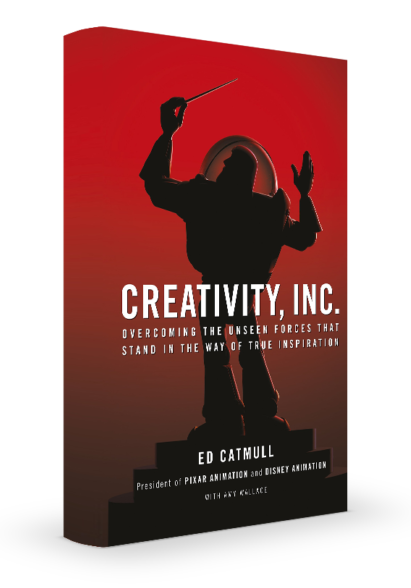What Project Managers Can Learn from Pixar
A Book Review on

Toys who were magically brought to life, a rat cooking in a French restaurant and monsters that scare children for a living. In their movies, Pixar has introduced the world to a plethora of creative characters. While keeping an extraordinary level of creativity, the company does not lack in terms of financial success either. Its most recent animation film, Incredibles 2, sold more tickets in the first week than any animation film has ever before. No other company in the film industry has even come close to the same level of constant success that Pixar, as a part of the Walt Disney Animation Studios, is having since the release of Toy Story in 1995.
This begs the question what are they doing differently in order to always come out on top. Ed Catmull, the president of Pixar Animation and (since 2006) Walt Disney Animation Studios, has stated the key elements of creativity in his book “Creativity, Inc.: Overcoming the Unseen Forces That Stand in the Way of True Inspiration”. Rather than being a generic guide on best practices for project management, this blog entry will explain how important creativity can be for companies and therefore show you what project managers can learn from Pixar.
1. The right team
“Give a good idea to a mediocre team and they will screw it up. Give a mediocre idea to a great team and they will either fix it or come up with something better. Chances are they’ll get the ideas right.”
A project can only be as good as the team being in charge of executing it. Therefore, it is elementary to start with a competent team. As the saying goes, A players hire A players while B players hire C players. However, competence is not only measured by being knowledgeable. Motivation and the potential to grow are also forces to reckon with. There might be potential team members who are currently not perfectly suited for the project but as long as they are motivated and eager to learn, don’t hesitate to give them a chance as well.
2. The right culture
“It isn’t enough merely to be open to ideas from others. Engaging the collective brainpower of the people you work with is an active, ongoing process. As a manager, you must coax ideas out of your staff and constantly push them to contribute.”
It can be regarded as the foundation of each and every single company: Its organizational culture. Sometimes it’s slightly different from other companies and sometimes there are hardly any resemblances at all. However, according to Catmull, there are a few key elements that allow organizations to be creative and act agile in order to improve their processes and thus achieve their goals.
Culture of Failure:
It is vital to accept failure. As Catmull states, failure needs to be regarded as a consequence of the new. If your company always stays in the comfort zone, there might be less failures but it will minimize the impact of the whole project since nothing new will be created. Therefore, your company needs to accept a culture of failure and take risks in order to become more effective in the long-run. As long as you use the learning effects gathered from missteps, short-term losses will pay out in the end leading to fundamental success.
Change is natural:
The world is driven by changes of all kinds. Sometimes major changes, like a new technological breakthrough, cause the downfall of complete industries (e.g digital cameras overtaking the analog camera industry). Sometimes even minor changes, like new laws, contradict with current company standards and therefore affect the way your company is working. In order to survive in times of rapid change, your company must accept change and uncertainty as a part of life. As soon as the necessity to change occurs, the company needs to act quickly in order to use the new situation to one’s advantage. This mindset must be at the core of a company’s culture and allows you to be more agile.
3. The right communication
“Do not discount ideas from unexpected sources. Inspiration can, and does, come from anywhere.”
There is a common misconception that ideas always come from one single person. The famous lightbulb that gets switched on in an instant is an omnipresent motive in many types of artwork. However, ideas rarely are being created in that way. Normally the shaping of an idea is based on a lot of brainstorming and influenced by many team members. If you want to take one thing from this article with you, it is the fact that you need to create and allow candid communication. That means everybody must be able to state whatever comes to his or her mind. Even if an idea cannot be realized, it might just be the right influence for another person to form something truly great.
4. The right execution
“The people ultimately responsible for implementing a plan must be empowered to make decisions when things go wrong, even before getting approval. Finding and fixing problems is everybody’s job. Anyone should be able to stop the production line.”
Hierarchy can be quite harmful if it prevents the company to run agile. Especially in a scenario, where every second is valuable to the success of the project, employees need to be empowered to make decisions directly. Realizing the importance of agile decision-making, the lean management giant Toyota has implemented the andon cord, a simple cord that can be pushed by every employee working at the assembly line as soon as a problem occurs. This simple cable has allowed Toyota to improve its production standards and boosted their efficiency.
5. The right evaluation
“First conclusions we draw from our successes and failures are normally wrong. Measuring the outcome without evaluating the process is deceiving.”
Once a project has ended, it is time to reflect on what went well and what didn’t. Embracing failure will only lead to success as long as you are able to learn from it. Discussions within the company on how certain problems were solved can help to institutionalize the learning effects for everybody. Additionally, employees must be measured by their potential to fix problems rather than by determining how many problems have occurred. Since failure is an inevitable part of being successful, it’s necessary to understand the circumstances and how problems were solved.

Conclusion
To sum it up, Pixar’s success can be measured by a few major elements that can be adapted by organizations everywhere:
- Hire A players who show the potential to grow.
- Empower them to take risks and even embrace failure but make sure that they reflect and gather vital learning effects.
- Don’t fear the uncertain but rather use it as an accelerator in times of change.
- Cherish candid communication. Allowing everyone to speak up openly is the purest form of improvement.
- Don’t draw conclusions based on how many problems have occurred but on how they were solved.

